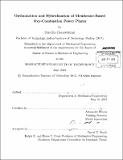| dc.contributor.advisor | Alexander Mitsos. | en_US |
| dc.contributor.author | Gunasekaran, Surekha | en_US |
| dc.contributor.other | Massachusetts Institute of Technology. Department of Mechanical Engineering. | en_US |
| dc.date.accessioned | 2013-10-24T17:33:54Z | |
| dc.date.available | 2013-10-24T17:33:54Z | |
| dc.date.copyright | 2013 | en_US |
| dc.date.issued | 2013 | en_US |
| dc.identifier.uri | http://hdl.handle.net/1721.1/81602 | |
| dc.description | Thesis (S.M.)--Massachusetts Institute of Technology, Dept. of Mechanical Engineering, 2013. | en_US |
| dc.description | Cataloged from PDF version of thesis. | en_US |
| dc.description | Includes bibliographical references (p. 103-108). | en_US |
| dc.description.abstract | This thesis considers the optimization and hybridization of advanced zero emissions power (AZEP) cycles. More specifically, existing flowsheets for zero and partial emissions are optimized, and new integration schemes with solar energy are proposed and analyzed. First, optimal design and operation of AZEP cycles, both zero and partial emissions, is considered. AZEP consists of a Brayton-like top cycle and a standard triple pressure heat recovery steam generator (HRSG) bottoming cycle, and a CO₂ separation and purification unit. The first-law efficiency is maximized as a function of CO₂ emissions with fixed ion transport membrane (ITM) size and consequently, variable power output. The optimization study involves 6 constraints, and 14 variables for the zero emissions cycle. The partial emissions cycle has one extra optimization variable. A two-step heuristic global optimization of the power cycle is performed. In the first step, the top cycle is optimized. In the next step, the bottoming cycle is optimized for fixed conditions of the top cycle. This procedure is repeated with different initial guesses for the optimization variables of the top cycle to obtain a near-global optimum. The optimization results in a significant increase in the efficiencies of AZEP100 and partial emissions cycles, in the range of 2-2.7 percentage points depending on cycle considered and ITM membrane temperature. This increase in efficiency is important with respect to viability of the partial emissions cycle compared to alternative power cycles. This viability is determined herein using a linear combination metric, which combines efficiency and CO₂ emissions. Optimization and simulations have shown that reducing the maximum membrane temperature results in an increase in the efficiency till membrane temperature reaches 850°C, after which the efficiency starts decreasing. However, reduced temperature results in dramatic drop in net power output of the power plant. In other words, membrane temperature results in a trade-off between power plant efficiency and power output. Second, different solar-thermal integration schemes for an AZEP cycle with total CO₂ capture are proposed and analyzed. The solar subsystem consists of a parabolic trough, a Concentrated Solar Thermal (CST) technology. Four different integration schemes with the bottoming cycle are considered: vaporization of high-pressure stream, preheating of high-pressure stream, heating of intermediate-pressure turbine inlet stream, and heating of low-pressure turbine inlet stream. The power outputs from these integration schemes are compared with each other and with the sum of the power outputs from corresponding standalone AZEP cycle and solar-thermal cycle. It is shown that vaporization of high-pressure stream in the bottoming cycle has the highest power output among the proposed integration schemes. The analysis shows that both the vaporization and heating of intermediate-pressure turbine inlet stream integration schemes have higher power output than the sum of the power outputs from corresponding stand-alone AZEP cycle and solar-thermal cycle. A comparison of the proposed vaporization scheme with existing hybrid technologies without carbon capture and sequestration (CCS) shows that it has a higher annual incremental solar efficiency than most hybrid technologies. Moreover, it has a higher solar share compared to -hybrid technologies with higher incremental efficiency. Hence, AZEP cycles are a promising option to be considered for solar-thermal hybridization. | en_US |
| dc.description.statementofresponsibility | by Surekha Gunasekaran. | en_US |
| dc.format.extent | 108 p. | en_US |
| dc.language.iso | eng | en_US |
| dc.publisher | Massachusetts Institute of Technology | en_US |
| dc.rights | M.I.T. theses are protected by
copyright. They may be viewed from this source for any purpose, but
reproduction or distribution in any format is prohibited without written
permission. See provided URL for inquiries about permission. | en_US |
| dc.rights.uri | http://dspace.mit.edu/handle/1721.1/7582 | en_US |
| dc.subject | Mechanical Engineering. | en_US |
| dc.title | Optimization and hybridization of membrane-based oxy-combustion power plants | en_US |
| dc.type | Thesis | en_US |
| dc.description.degree | S.M. | en_US |
| dc.contributor.department | Massachusetts Institute of Technology. Department of Mechanical Engineering | |
| dc.identifier.oclc | 858868269 | en_US |
